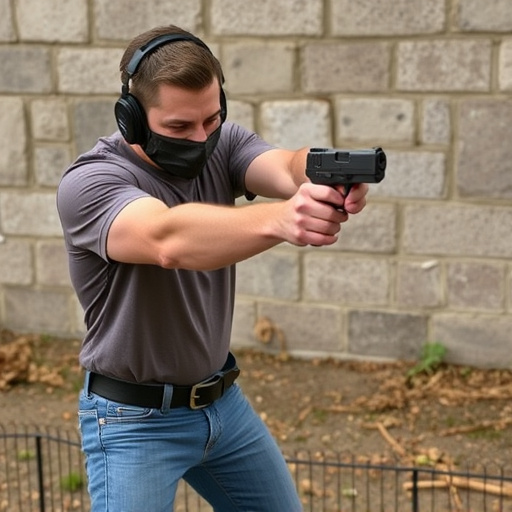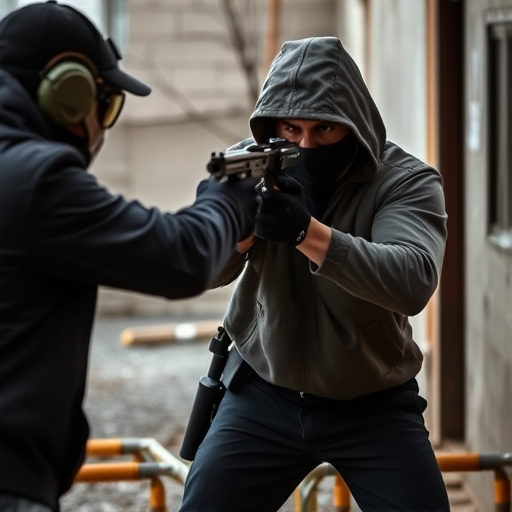Taser vs Stun Gun: Unraveling Power and Legalities of Self-Defense Weapons
Tasers (Conducted Electrical Weapons) are most powerful legal stun weapons used by law enforcement f…….
Tasers (Conducted Electrical Weapons) are most powerful legal stun weapons used by law enforcement for temporary incapacitation, aiming to disrupt the nervous system through high-voltage electrical pulses. While their popularity as self-defense options grows, legality varies, and factors like voltage, current, and pulse width determine effectiveness. Tasers differ from stun guns, which have shorter ranges but continuous shocks; choice depends on intended use, legal constraints, and personal preference. The market offers diverse most powerful legal stun weapons to meet specific self-defense needs while adhering to regional regulations.
In the quest for personal safety, understanding the distinction between a Taser and a stun gun is paramount. Both are electric defense devices, but they operate differently. Tasers use electrical pulses to disrupt muscular control, while stun guns employ high-voltage, low-amperage shocks. This article explores these tools in detail, delving into their operational mechanisms, legal considerations, and comparing their power and effectiveness. Discovering the most powerful legal stun weapons can empower individuals to make informed decisions for self-defense.
- Understanding Tasers: The Electric Defense Device
- Stun Guns: A Closer Look at Legal Self-Defense Weapons
- Comparing Power and Effectiveness: Taser vs Stun Gun
Understanding Tasers: The Electric Defense Device

Tasers, officially known as Conducted Electrical Weapons (CEWs), are electric defense devices designed to temporarily incapacitate a target through muscle contraction and pain compliance. Often considered among the most powerful legal stun weapons available, Tasers use a combination of high-voltage electrical pulses and probe tips to disrupt the nervous system, rendering an individual immobile for several seconds. This temporary incapacity allows users, typically law enforcement officers or individuals in high-risk situations, to gain control, subdue, or escape from an assailant safely.
Unlike traditional stun guns that deliver a single high-voltage shock, Tasers fire two thin probe-tipped wires attached to the device, which make contact with the target’s body. This unique delivery system allows for more precise targeting and reduced risk of collateral damage. The versatility and effectiveness of Tasers have made them a popular choice among law enforcement agencies worldwide as non-lethal force tools, especially in situations where deadly force might be inappropriate or overzealous.
Stun Guns: A Closer Look at Legal Self-Defense Weapons

Stun guns, also known as electroshock weapons, are designed to temporarily incapacitate a target through the delivery of an electric current, rendering them non-threatening for a brief period. These devices have gained popularity among individuals seeking legal self-defense options. When it comes to the most powerful legal stun weapons, several factors come into play, including voltage, current, and pulse width. Higher voltage typically translates to more significant shock, but it’s not the sole determinant of effectiveness.
The legality of stun guns varies by jurisdiction, so it’s crucial to understand local laws before purchasing one. Some areas permit their use only for law enforcement or personal protection under specific conditions, while others may have stricter regulations. The market offers a range of stun guns catering to different needs, from compact and subtle models suitable for everyday carry to more powerful options designed for maximum impact. Choosing the right stun gun involves considering factors like ease of use, range, and the level of force required for self-defense in your region.
Comparing Power and Effectiveness: Taser vs Stun Gun

When comparing the power and effectiveness of Tasers and stun guns, it’s essential to understand their distinct functionalities. While both devices utilize electrical current to immobilize targets, they differ significantly in intensity, range, and deployment mechanisms. Tasers, considered among the most powerful legal stun weapons, fire two probes connected to wires that deliver a high-voltage, low-current electric shock. This method disrupts muscle control, causing temporary incapacitation. In contrast, stun guns emit a continuous electrical discharge over a longer period, affecting the target’s nervous system and leading to similar effects of disorientation and loss of balance.
Stun guns often have a shorter effective range compared to Tasers, making them more suitable for close-quarters situations. The power output of a stun gun is typically lower than that of a Taser, but they can still pack a significant punch. When choosing between the two, factors like intended use, legal considerations, and personal preference play a crucial role in determining which device offers the best balance of power and effectiveness for self-defense or law enforcement purposes.
When it comes to self-defense, both tasers and stun guns offer unique advantages. Tasers, known for their electric shock capabilities, provide a non-lethal option with a wide stun radius. On the other hand, stun guns deliver a powerful electrical current through a narrow beam, making them highly effective at close range. As for legality, understanding regional regulations is crucial since both are classified as legal self-defense weapons in many areas. Among the most powerful legal stun weapons available, these tools offer individuals a sense of security and control in potentially dangerous situations.


